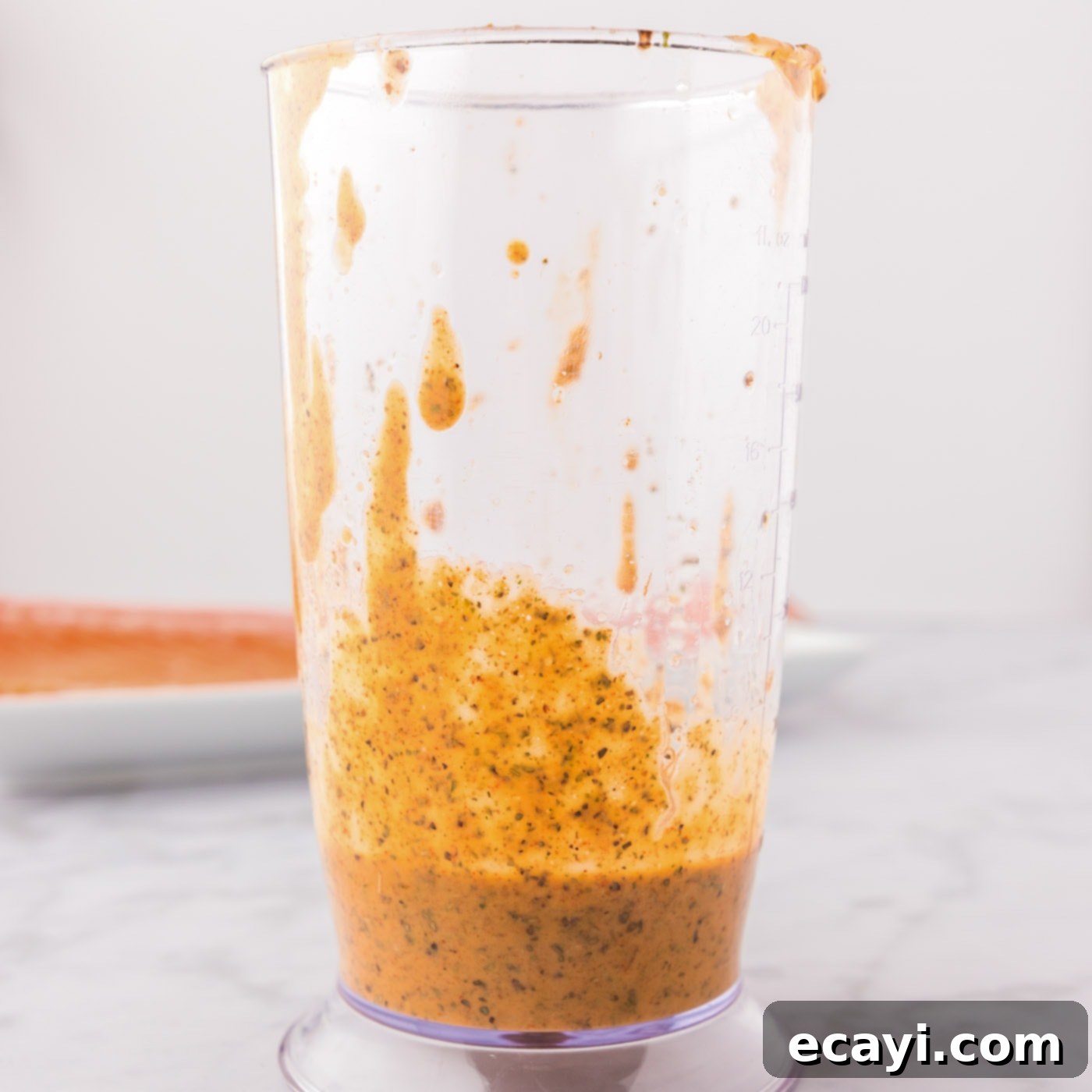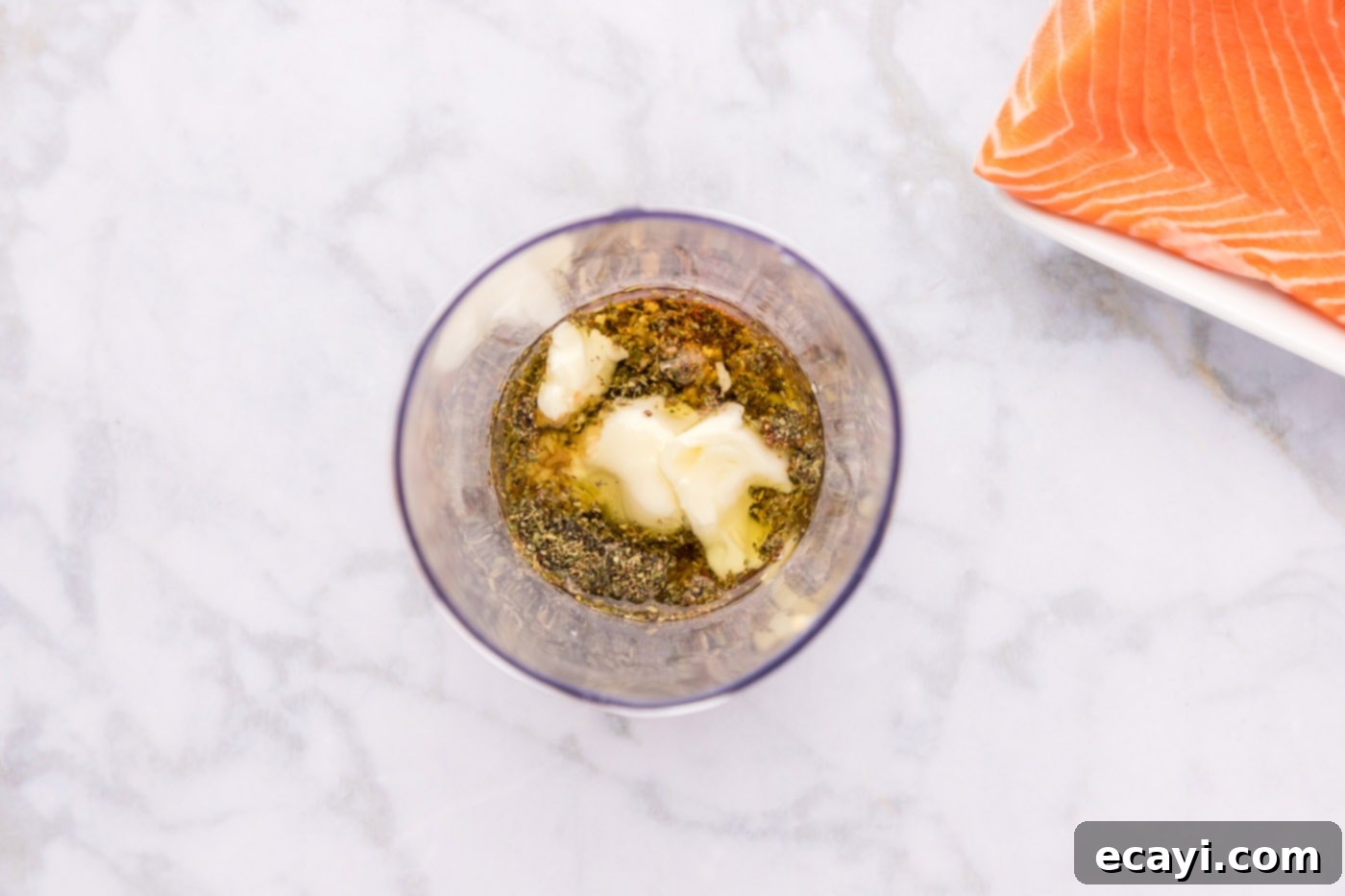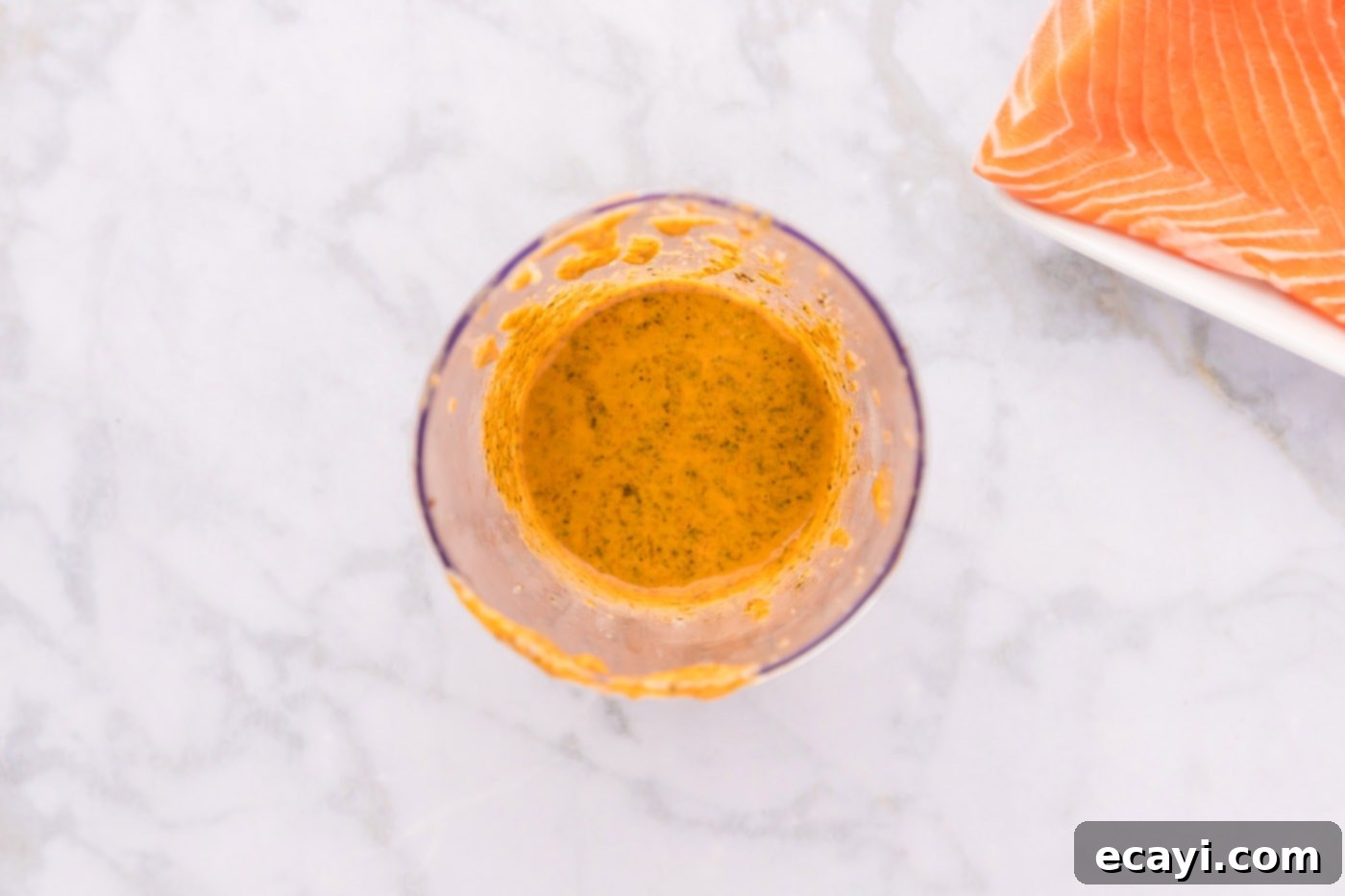The Best Easy Salmon Marinade: Unlock Flavor & Tenderness for Perfect Fish Every Time
Transform your salmon fillets from good to gourmet with this incredibly simple yet profoundly flavorful salmon marinade. Crafted from everyday pantry staples like butter, fragrant garlic, rich olive oil, and bright lemon juice, this marinade infuses your fish with unparalleled taste and moisture. Whether you prefer to bake, grill, pan-sear, or air fry your salmon, this versatile recipe guarantees a delicious, flaky result every single time.
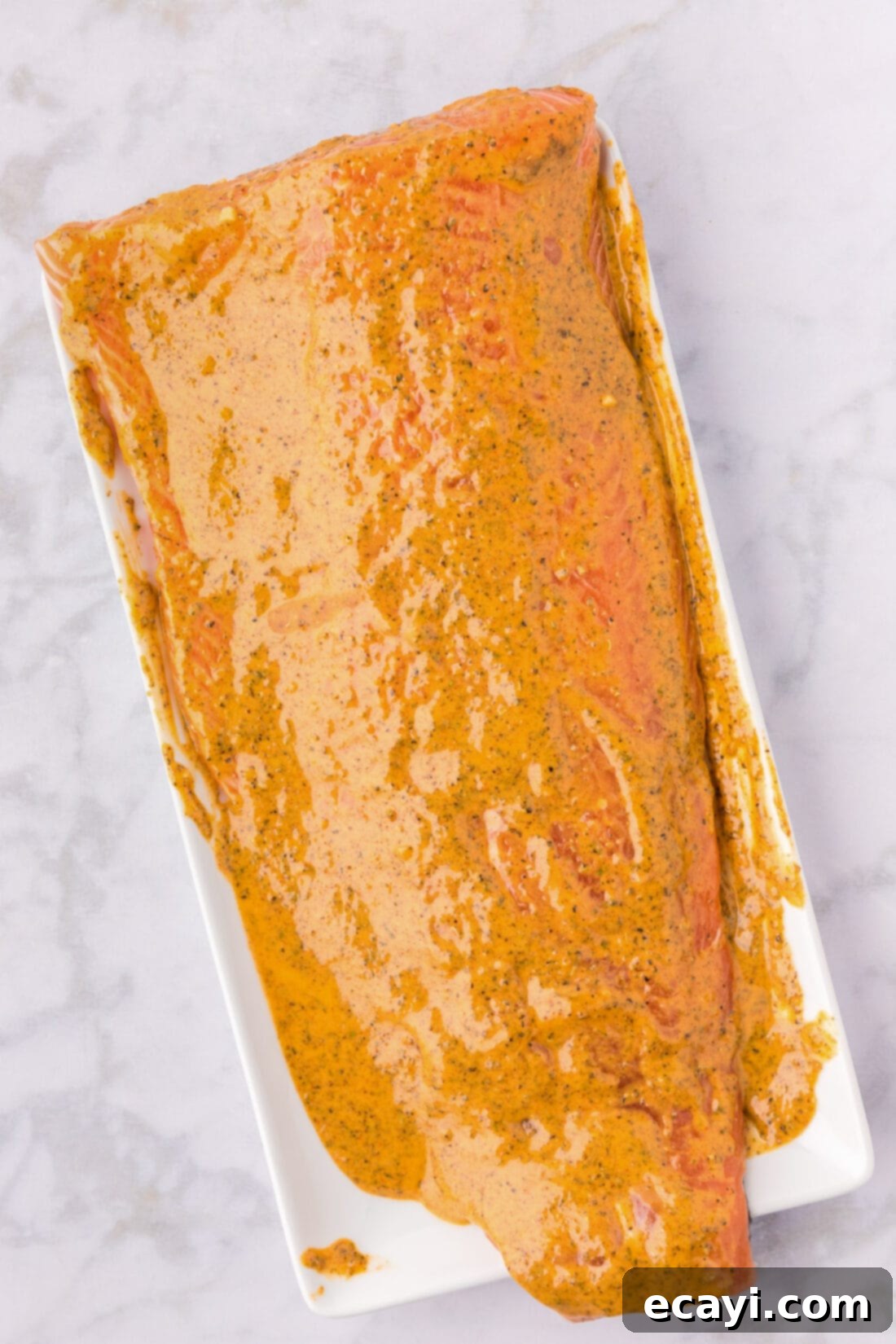
Why This Simple Salmon Marinade is a Game-Changer
Incorporating a marinade into your salmon preparation is more than just adding flavor; it’s a culinary secret to achieving perfectly tender and moist fish. While salmon is inherently delicious, its mild flavor profile makes it an ideal canvas for robust marinades. This particular recipe stands out because it combines essential elements that tenderize the fish, boost its natural taste, and lock in moisture, all within a short marinating time.
Many home cooks wonder, “Is marinating salmon really necessary?” While a quick seasoning rub or a drizzle of olive oil with herbs can certainly suffice, a proper marinade elevates salmon to a new level. Our carefully balanced blend of acidic lemon juice, rich butter, aromatic garlic, and a medley of seasonings works synergistically to:
- Tenderize the Fillets: The mild acidity from the lemon juice gently breaks down the proteins in the salmon, resulting in a more tender texture. This is especially beneficial for thicker cuts.
- Infuse Deep Flavor: Unlike a surface rub, a marinade penetrates the fish, ensuring every bite is bursting with savory, zesty notes. The combination of garlic salt, black pepper, Italian seasoning, and paprika creates a harmonious flavor profile that complements salmon beautifully.
- Enhance Moisture: The olive oil and melted butter in the marinade add a layer of fat and moisture that helps prevent the salmon from drying out during cooking, leading to that coveted, pull-apart flaky texture.
Best of all, this marinade comes together in just a few minutes, requiring only an hour of marinating time to imbue the salmon with all its fantastic flavors. This makes it perfect for weeknight dinners when you need something quick yet impressive. Its versatility extends beyond salmon; feel free to try it with other hearty fish like sea bass, tilapia, or catfish for equally stunning results.
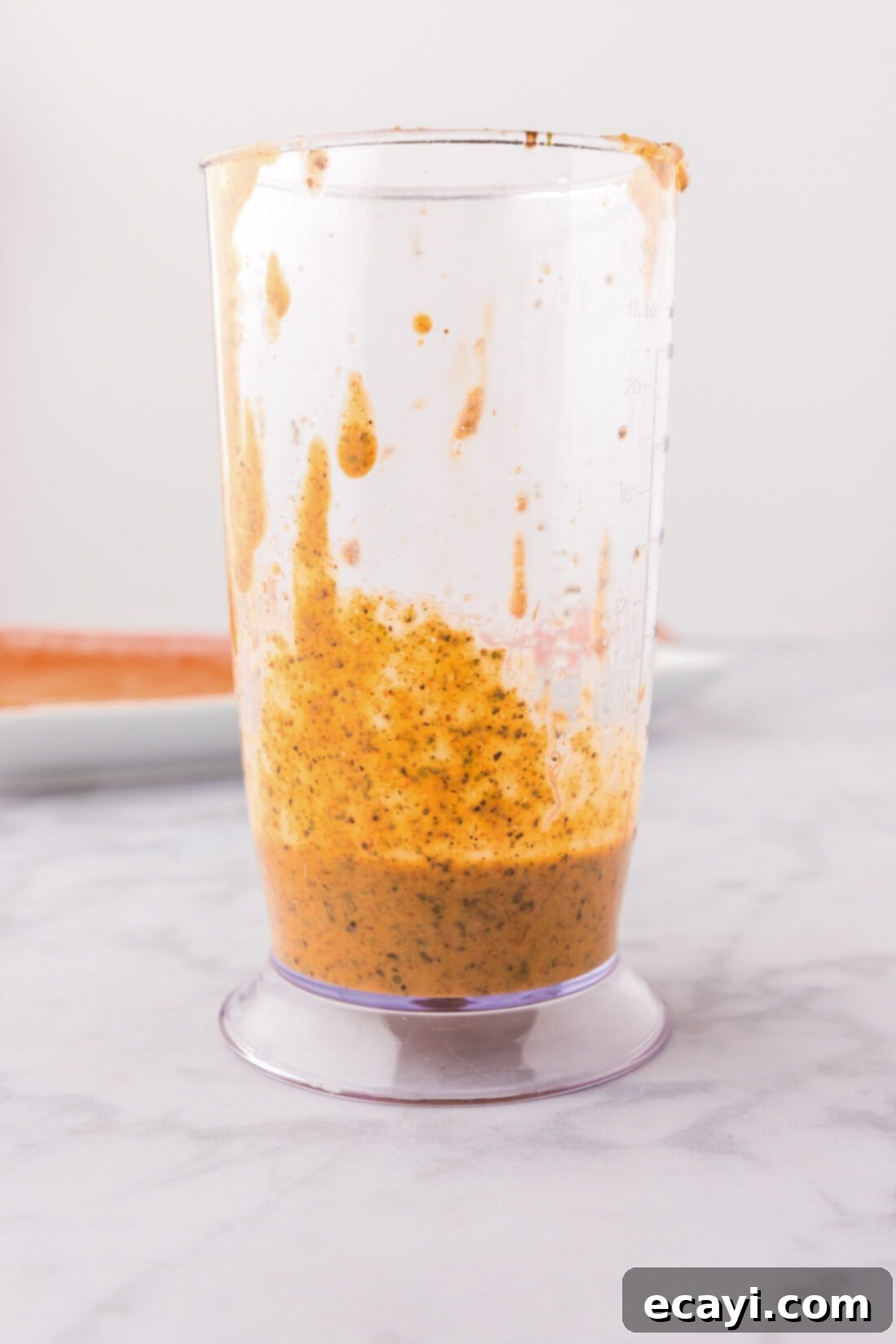
Key Ingredients for Your Flavorful Salmon Marinade
Crafting this incredible salmon marinade relies on a few simple, accessible ingredients you likely already have in your kitchen. Here’s what you’ll need to gather:
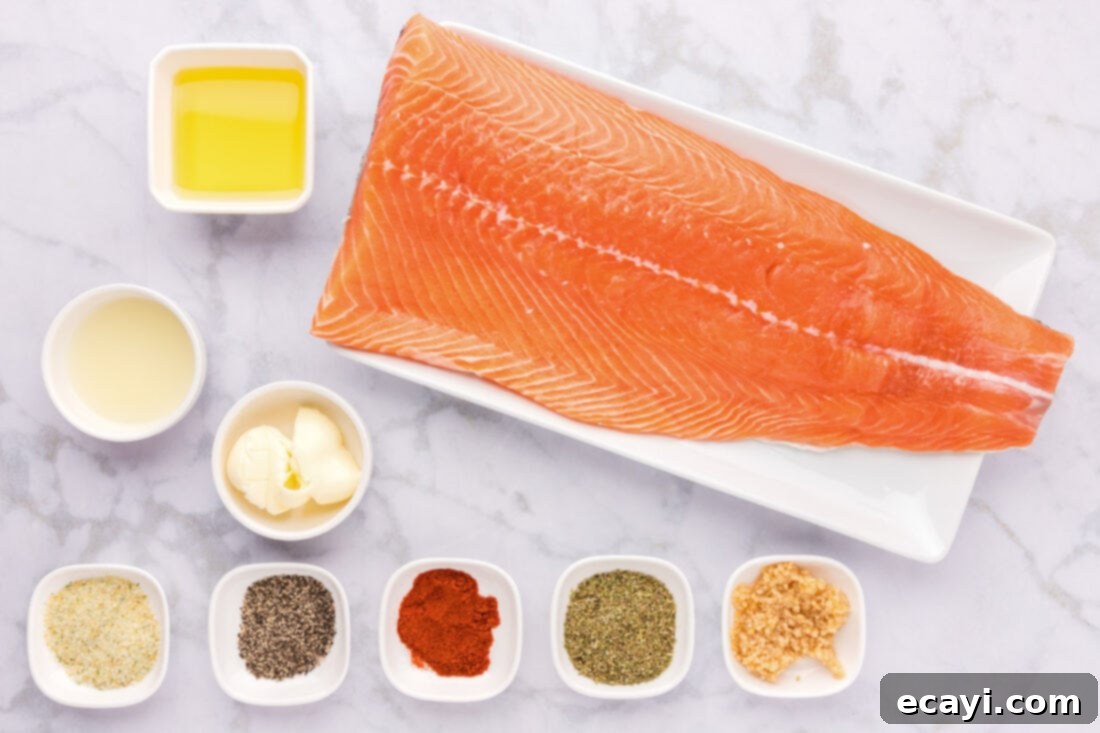
Ingredient Spotlight & Expert Substitution Tips
Understanding each ingredient’s role and knowing possible substitutions will empower you to customize this marinade to your taste and what you have on hand.
- Salmon: This recipe yields about 1/2 cup of marinade, which is perfectly portioned for 1 1/2 to 2 pounds of center-cut salmon or individual fillets. If you’re cooking for a crowd, simply double or triple the recipe as needed. When selecting salmon, look for firm, bright flesh with a fresh, ocean-like smell (not fishy). Both skin-on and skin-off fillets work wonderfully with this marinade. Skin-on salmon often results in crispier skin when pan-searing or grilling, which can add an extra layer of texture. For more variety, explore all our salmon recipes.
- Butter (Room Temperature): Butter adds a lovely richness and helps the marinade emulsify smoothly. Using room temperature butter is crucial for easy blending. If your butter is cold, you can gently microwave it for a few seconds until just softened, but not melted into a liquid. For a dairy-free option, use a plant-based butter alternative. Ghee can also work for a slightly nutty flavor.
- Garlic Salt: This convenient seasoning provides both a savory garlic kick and the necessary salt to draw out moisture and flavor. If you prefer to use regular salt, reduce the amount and add about 1 teaspoon of garlic powder to achieve a similar garlic intensity. Adjust salt to your preference.
- Black Pepper: Freshly ground black pepper offers the best aroma and flavor. A coarse grind adds a subtle textural element, while a fine grind integrates more smoothly.
- Italian Seasoning: A blend of dried herbs like oregano, basil, thyme, rosemary, and marjoram, Italian seasoning brings an aromatic, herbaceous depth to the marinade. If you don’t have a pre-made blend, you can create your own by combining equal parts of dried oregano, basil, and thyme, with a pinch of rosemary.
- Minced Garlic: Freshly minced garlic provides a potent, pungent flavor that is superior to jarred garlic. However, jarred minced garlic is a convenient substitute if time is short. Roughly 3 cloves of fresh garlic equal 1 tablespoon of minced garlic.
- Lemon Juice: Freshly squeezed lemon juice is highly recommended for its bright, zesty flavor that cuts through the richness of the salmon and butter. It’s also the key acidic component that aids in tenderizing the fish. If fresh lemons aren’t available, high-quality bottled lemon juice can be used, though the flavor might be slightly less vibrant. Lime juice can be a fantastic alternative for a different citrus twist.
- Olive Oil: Extra virgin olive oil provides a fruity, peppery base for the marinade, helping to carry the flavors and add moisture. It also aids in preventing the fish from sticking to cooking surfaces. A good quality olive oil makes a noticeable difference. If you prefer a more neutral flavor, avocado oil or grapeseed oil can be used.
Whipping Up Your Easy Salmon Marinade: Step-by-Step
These step-by-step photos and instructions are here to help you visualize how to make this recipe. For the complete printable version with exact measurements and instructions, scroll down to the Jump to Recipe button at the bottom of this post.
- Combine All Ingredients: Add all the measured ingredients – room temperature butter, garlic salt, black pepper, Italian seasoning, paprika, minced garlic, lemon juice, and olive oil – into an immersion blender cup or a regular blender.

- Blend Until Smooth: Use your immersion blender or regular blender to process the ingredients until the mixture is completely smooth and well combined. This ensures all the flavors are evenly distributed.

- Marinate the Salmon: Place your salmon fillets in a shallow dish or a zip-top bag. Pour the prepared marinade over the fish, ensuring each piece is thoroughly coated. Cover the dish or seal the bag and refrigerate for one hour before you plan to cook.
How to Marinate Salmon Effectively
Once your flavorful marinade is ready, proper marinating technique is key to achieving the best results. Follow these steps for an optimally flavored and tender salmon:
- Prepare the Salmon: Before marinating, gently pat your salmon fillets dry with paper towels. This removes excess surface moisture, allowing the marinade to adhere better and promoting a better sear or crust during cooking.
- Choose Your Container: Place the salmon fillets in a non-reactive container. A zip-top bag is ideal as it allows for maximum surface contact with the marinade and easy cleanup. Alternatively, a shallow glass dish or ceramic baking dish works well. Avoid metal containers, as the acidity in the lemon juice can react with the metal.
- Coat Evenly: Pour the entire batch of marinade over the salmon. Ensure each piece is thoroughly coated. If using a zip-top bag, gently massage the bag to distribute the marinade evenly around the fish.
- Refrigerate: Seal the bag or cover the dish tightly and place it in the refrigerator. For this acid-based marinade, we recommend marinating for 30 minutes to one hour. This timeframe is crucial to allow the flavors to penetrate and the lemon juice to tenderize the fish without overdoing it.
- Do Not Over-Marinate: It’s important not to marinate salmon with an acid-based marinade for longer than one hour. The acidity can begin to “cook” the delicate proteins in the fish, leading to a mushy or rubbery texture when cooked. For marinades that don’t contain acidic ingredients, salmon can safely marinate for up to 12-24 hours in the refrigerator.
- Discard Used Marinade: For food safety, never reuse marinade that has been in contact with raw fish. Always discard it after the salmon has been removed. If you wish to use some marinade as a sauce, set a portion aside *before* adding it to the raw fish.
Versatile Cooking Methods for Your Marinated Salmon
One of the greatest advantages of this salmon marinade is its adaptability. It performs beautifully across a variety of cooking methods, ensuring your salmon is perfectly cooked and flavorful no matter how you choose to prepare it.
- Baking:
- Preheat your oven to 400°F (200°C).
- Line a baking sheet with parchment paper for easy cleanup and to prevent sticking.
- Place the marinated salmon fillets skin-side down (if applicable) on the prepared baking sheet.
- Bake for 12-18 minutes, or until the salmon is opaque and flakes easily with a fork. Cooking time will vary based on the thickness of your fillets.
- Grilling:
- Preheat your grill to medium-high heat (around 400-450°F / 200-230°C).
- Lightly oil the grill grates to prevent sticking.
- Place the salmon fillets skin-side down on the hot grill. Close the lid.
- Grill for 5-7 minutes per side for thicker fillets, or until cooked through and nicely charred. The skin should be crispy, and the flesh should flake easily.
- For best results, avoid moving the fish too much to get good grill marks and prevent it from falling apart.
- Pan-Searing:
- Heat a heavy-bottomed skillet (cast iron or stainless steel works best) over medium-high heat. Add a tablespoon of olive oil or butter if desired, though the marinade provides plenty of fat.
- Once the pan is hot, place the salmon fillets skin-side down in the pan.
- Sear for 4-6 minutes, pressing gently with a spatula to ensure even contact for crispy skin.
- Flip the salmon and cook for another 3-5 minutes, or until cooked to your desired doneness.
- Air Frying:
- Preheat your air fryer to 375°F (190°C).
- Lightly spray the air fryer basket with non-stick spray.
- Place the marinated salmon fillets in a single layer in the basket, ensuring they are not overcrowded. Cook in batches if necessary.
- Air fry for 8-12 minutes, flipping halfway through, until the salmon is golden and cooked through.
- Oven Roasting/Baking: (Similar to baking, but often refers to slightly higher temps or different setup)
- Preheat oven to 425°F (220°C).
- Place marinated salmon on a foil-lined baking sheet.
- Roast for 10-15 minutes, depending on thickness, until opaque and easily flaked.
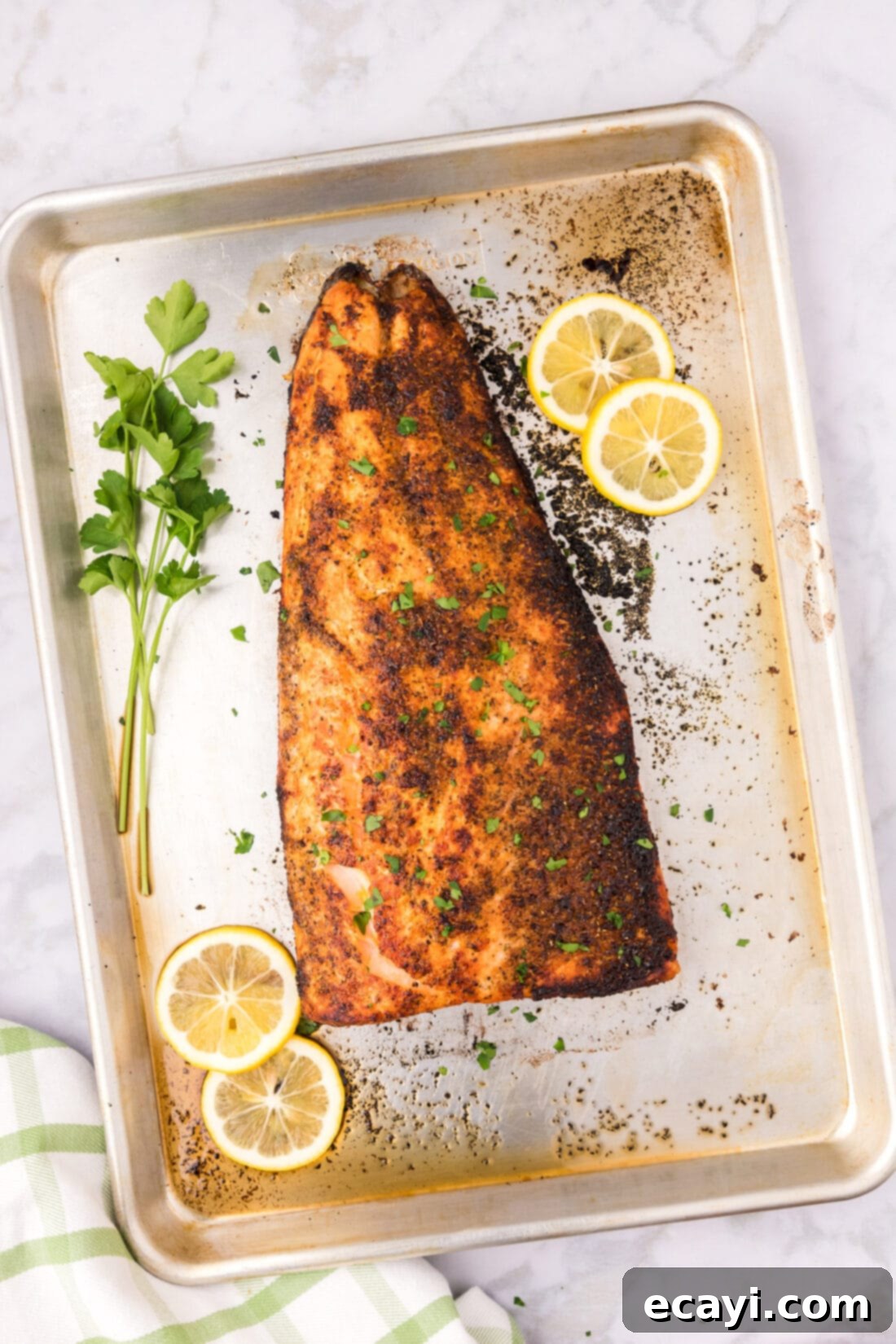
Frequently Asked Questions & Expert Tips for Perfect Salmon
For this specific salmon marinade, which is acid-based due to the lemon juice, we strongly suggest marinating for only 30 minutes to one hour. Marinating longer than this risks the salmon becoming mushy because the acidity starts to break down the delicate fish proteins, effectively “cooking” it chemically. For other types of marinades that are not acid-based (e.g., oil and herb-only blends), it is generally safe to marinate salmon for 12-24 hours in the refrigerator.
Absolutely! You can prepare this marinade up to 3-4 days in advance. Store it in an airtight container in the refrigerator. Give it a good whisk or blend again before using if the ingredients have separated.
The best way to tell if salmon is cooked is by checking its internal temperature with an instant-read thermometer. Salmon is safe to eat at 145°F (63°C). Visually, the flesh should be opaque and flake easily with a fork in the thickest part of the fillet.
While possible, it’s generally not recommended to freeze raw salmon *in* this particular acid-based marinade. The freezing and thawing process, combined with the acid, could further degrade the fish texture. It’s best to marinate fresh or thawed salmon for the recommended time just before cooking. You can freeze the prepared marinade separately for later use.
This marinade works well with all common types of salmon, including Atlantic, Sockeye, Coho, and King salmon. Atlantic salmon is often praised for its rich, buttery flavor and tender texture, making it an excellent choice. Sockeye has a firmer texture and a more pronounced “salmon” flavor.
- Pat Dry for a Better Sear: Always pat your salmon fillets thoroughly dry with paper towels before applying the marinade. This helps create a beautiful crust when searing or grilling.
- Don’t Rush the Chill: Ensure the salmon marinates in the refrigerator. This keeps it safe and allows the flavors to properly meld.
- Room Temperature Salmon (Optional): For more even cooking, consider taking the marinated salmon out of the refrigerator about 15-20 minutes before cooking. This helps it come closer to room temperature, preventing the outside from overcooking before the inside is done.
- Rest Your Fish: Just like meat, salmon benefits from a few minutes of resting after cooking. This allows the juices to redistribute, resulting in a juicier, more tender fillet.
- Skin-On Advantage: If you enjoy crispy skin, opt for skin-on salmon and cook it skin-side down for most of the cooking time, especially when pan-searing or grilling.
Delicious Serving Suggestions for Your Marinated Salmon
The beauty of this simple yet robust salmon marinade is that it leaves ample room for creativity when it comes to side dishes. Its balanced flavor profile pairs beautifully with a wide array of accompaniments, allowing you to tailor your meal to any occasion or preference.
For a light and healthy meal, consider serving your marinated salmon with steamed or roasted vegetables. Classic choices like crisp asparagus, vibrant green beans, tender broccoli, or sweet corn perfectly complement the fish without overpowering its flavor. Roasting root vegetables such as potatoes or carrots alongside your salmon can also create a hearty and satisfying plate, with the earthy sweetness of the vegetables balancing the savory notes of the fish.
If you’re looking for a more substantial meal, grains and pasta are excellent partners. Fluffy rice, especially a simple white or brown rice, provides a neutral base that soaks up any lingering marinade juices. For a burst of citrusy freshness that mirrors the lemon in the marinade, try a light and zesty lemon couscous. Pasta, tossed with a light olive oil and herb sauce, or even a creamy alfredo for a richer experience, also pairs wonderfully. A fresh side salad with a vinaigrette dressing can add a refreshing contrast and texture.
Don’t forget garnishes! A sprinkle of fresh chopped parsley, dill, or chives can add a touch of color and a fresh herbaceous note just before serving. A final squeeze of fresh lemon wedge can also brighten the entire dish.
Explore More Delectable Salmon Recipes
If you loved this salmon marinade and are eager to try more ways to prepare this incredibly healthy and versatile fish, you’re in luck! Here are some other fantastic salmon recipes to inspire your next meal:
- Salmon Sauce
- Grilled Salmon
- Roasted Salmon
- Air Fryer Salmon
- Pan Seared Salmon
- Instant Pot Salmon
I love to bake and cook and share my kitchen experience with all of you! Remembering to come back each day can be tough, that’s why I offer a convenient newsletter every time a new recipe posts. Simply subscribe and start receiving your free daily recipes!
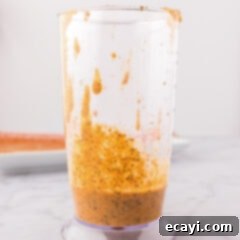
Salmon Marinade
Incorporating a marinade into your salmon dish is a great way to switch up this mild-flavored fish. It only takes a few minutes to throw together and up to one hour to soak up all the flavors, resulting in incredibly moist and tender salmon.
IMPORTANT – There are often Frequently Asked Questions within the blog post that you may find helpful. Simply scroll back up to read them!
Pin It
Course: Condiments
Cuisine: American
Servings: 4 serving (1/2 cup total)
Total Time: 1 hr 5 mins
Calories: 170
Author: Amanda Davis
Ingredients
- 1 ½ Tablespoons butter, room temperature
- 2 teaspoons garlic salt
- 1 ½ teaspoons black pepper
- 1 Tablespoon Italian seasoning
- 2 teaspoons paprika
- 1 Tablespoon minced garlic
- 2 Tablespoons lemon juice
- ¼ cup olive oil
Things You’ll Need
- Immersion blender (or regular blender)
- Measuring spoons
- Liquid measure
Before You Begin (Important Notes)
- This recipe yields 1/2 cup of salmon marinade, which is sufficient for 1 1/2 pounds to 2 pounds of center-cut salmon (or roughly 4 fillets). Double or triple the recipe as needed for larger quantities.
- This marinade is incredibly versatile and can be used with almost any cooking method, including baking, grilling, pan-searing, or air frying.
- Due to its acid base, we highly recommend marinating the salmon for 30 minutes to one hour. Exceeding this time frame can cause the delicate salmon to become mushy.
Instructions
- Add all ingredients (butter, garlic salt, black pepper, Italian seasoning, paprika, minced garlic, lemon juice, and olive oil) to an immersion blender cup or a regular blender.
- Blend until the mixture is completely smooth and all ingredients are well combined.
- To use the marinade, place your salmon fillets in a shallow dish or zip-top bag, pour the marinade over, ensuring it’s evenly coated, and allow it to sit in the refrigerator for one hour before cooking.
Nutrition
Serving: 1 serving | Calories: 170 cal | Carbohydrates: 3g | Protein: 1g | Fat: 18g | Saturated Fat: 5g | Polyunsaturated Fat: 2g | Monounsaturated Fat: 11g | Trans Fat: 0.2g | Cholesterol: 11mg | Sodium: 1198mg | Potassium: 66mg | Fiber: 1g | Sugar: 0.4g | Vitamin A: 650 IU | Vitamin C: 4mg | Calcium: 32mg | Iron: 1mg
Tried this Recipe? Pin it for Later!
Follow on Pinterest @AmandasCookin or tag #AmandasCookin!
The recipes on this blog are tested with a conventional gas oven and gas stovetop. It’s important to note that some ovens, especially as they age, can cook and bake inconsistently. Using an inexpensive oven thermometer can assure you that your oven is truly heating to the proper temperature. If you use a toaster oven or countertop oven, please keep in mind that they may not distribute heat the same as a conventional full sized oven and you may need to adjust your cooking/baking times. In the case of recipes made with a pressure cooker, air fryer, slow cooker, or other appliance, a link to the appliances we use is listed within each respective recipe. For baking recipes where measurements are given by weight, please note that results may not be the same if cups are used instead, and we can’t guarantee success with that method.
